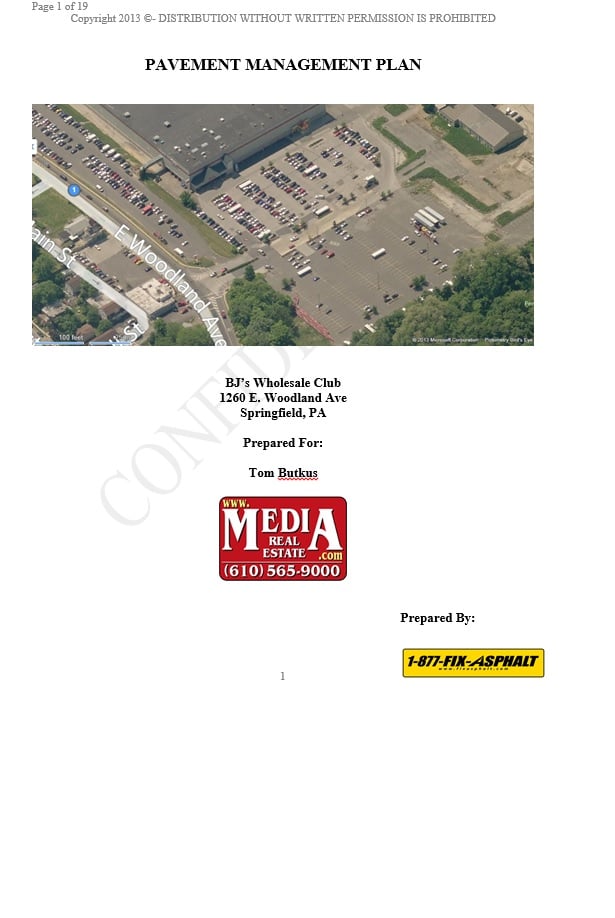What Is A Pavement Management Plan For Property & Facility Managers?

 Pavement Management Planning consists of a computerized, planned, systematic approach in optimizing pavement maintenance and rehabilitation services to provide the desired level of pavement condition and life span with available budget dollars. Implementation of PMP results in identification of needs of the pavement system and schedules for maintenance and rehabilitation to address identified needs. PMP considers current and future pavement condition, maintenance and rehabilitation alternatives, budget dollar allocation and long-term priorities to develop maintenance and rehabilitation plans and schedules to achieve desired goals.
Pavement Management Planning consists of a computerized, planned, systematic approach in optimizing pavement maintenance and rehabilitation services to provide the desired level of pavement condition and life span with available budget dollars. Implementation of PMP results in identification of needs of the pavement system and schedules for maintenance and rehabilitation to address identified needs. PMP considers current and future pavement condition, maintenance and rehabilitation alternatives, budget dollar allocation and long-term priorities to develop maintenance and rehabilitation plans and schedules to achieve desired goals.
Individual maintenance options such as Asphalt Saw Cut & Infrared Repairs, Asphalt Sealcoating, Hot Rubberized Crack Sealing and Line Striping should all be used in an active preventative maintenance plan for your parking lots. But execution of only one or two of these techniques is (at best) a one-shot effort to forestall the inevitable deterioration of the asphalt pavement. By using several maintenance approaches together designed as a “system”, one to support the other, you compound the advantages of each singular approach which will significantly extend the life of your pavement – and save money.
This ultimate goal behind a Pavement Management Plan is designed to stretch budget dollars and simplify the job of the property / facility manager, and is based on the idea that the timing of the repair is as important as the repairs themselves.
Pavement Management Planning: A Management Tool
As a management tool this plan enables you to plan your pavement maintenance so you can maintain your parking lots in the most cost-effective way. Pavement Management Planning is a systematic, long-term approach (we recommend looking anywhere from two to five years down the line) that ties together all the various maintenance options under one plan. Because it is a long-range plan, it enables you to budget your repairs, giving you greater control over your maintenance expenses – and it gives you the best chance you can have of getting the most bang for your maintenance buck.
PMP Pavements in Varying Conditions
Pavements in different condition ranges require different types of maintenance and rehabilitation activities. Applicable procedures range from minor routine maintenance to total reconstruction depending on pavement condition. Specific procedures selected may vary depending on performance levels in different areas and for different functions. Each procedure used in PMP has an associated cost, pavement condition improvement level and life cycle.
Steps in Pavement Management
- Inventory
A physical inventory of each parking lot is completed by using aerial diagrams. This function consists of identifying, describing, and logging the pavement system into our database which describes the entire pavement system to be managed. Both concrete and asphalt are itemized, along with automobile and pedestrian traffic flow, noting entrances and exits, drainage, islands, delivery areas and dumpsters, etc., everything encountered is measured and recorded in a software program. Pavement defects such as depressions, rutting, all cracking by type and severity, potholes, saw cut repairs, are noted, photographed and mapped. - Condition Survey
The condition of each inventory section is assessed by various methods. This phase identifies the pavement condition of each section. Therefore, once the inventory is completed, all of the information on digital maps is correlated to match the parking lot, with each damaged area and type of repair indicated. Condition surveys are generally performed each year to monitor performance of the pavement system and can be completed bi-yearly for added protection. - Identify Maintenance and Rehabilitation Alternatives
Pavement defects and recommend repairs are ranked. Rather than rank them from the worst pavement areas to the best, they are typically ranked from the most cost-effective repair to least cost-effective repair. The pavement defects are prioritized starting with the most important to fix first – not in order of severity, and here’s why. In many cases, it is more cost effective to let certain defects go a year or two and repair other defects in the meantime. That’s because some repairs – rather than fix a defect – will prevent more costly defects from occurring. - Operate the System
With the pavement inventory, condition survey and maintenance and rehabilitation alternatives it is then possible to model pavement condition with various rehabilitation strategies (procedures and timing) to determine future pavement condition and associated cost. Rehabilitation strategies can then be optimized considering goals and funding. Work schedules are then produced and priorities and budgets set. Maintenance and rehabilitation are then performed as scheduled. - Monitoring the Schedule
During operation of PMP, condition data is collected to monitor and verify if maintenance and rehabilitation procedures used are producing predicted results. Performance predictions are updated as data becomes available. Other changes can be made in the system as data acquisition, rehabilitation and performance prediction technology improves.
Summary
The maintenance of your pavement is as important as the maintenance on your car. You wouldn’t risk not taking your car in for routine tune-ups or oil changes, so why take chances with your parking lot. Viewing pavement maintenance as an investment and not as an expense is one way to avoid costly repairs. If you rely on the Pavement Management Plan, you will be able to better schedule your pavement repairs for a time when they will be the most cost-effective, and, you will be able to plan your maintenance expenses better, which means you will be able to budget your expenses more accurately.
To learn more about how we can help you save thousands of dollars through planned preventative maintenance versus costly reactive maintenance, please click below:











Leave a Comment